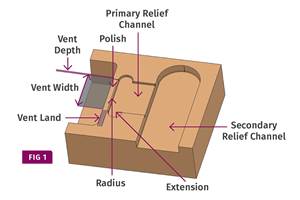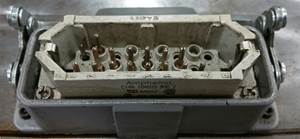How to Specify A Resin Dryer
Injection Molding Know How
To dry your polymer correctly you need a dryer that is properly designed and working properly. Here are my suggested specifications, for a two-, three- or four-bed desiccant dryer, the most common types used.
First, you need to understand why you dry many of the polymers you use. To get the moisture out, yes, but that does not address the underlying reason: You dry these polymers so you do not get polymer chain degradation, known as hydrolysis. Polymers get their properties by being tangled long chains. Many hygroscopic (moisture-absorbing) polymers, like nylons, get broken up into shorter chains if processed with moisture. The humidity or moisture acts like a pair of scissors that cuts up the long polymer chains. The longer the chain, the better the properties; the shorter the chain, the poorer. Moisture-induced chain breakage also changes the melt viscosity during processing.
You leave your fingerprint on the part if you do not dry it properly. Checking for molecular-weight degradation—i.e., shorter chains—is not time consuming or expensive. I suggest you check it periodically if you are not monitoring viscosity during production. It is critically important to dry these moisture-sensitive, hygroscopic polymers correctly so they perform as intended in the field—and for process stability. Also, you have only about 15 min to use dried resin before it picks up enough moisture from the air to be a problem.
To dry your polymer correctly you need a dryer that is properly designed and working properly. Here are my suggested specifications, for a two-, three- or four-bed desiccant dryer, the most common types used. These specifications would apply as well to ceramic-cone dryers. Much of the hardware issues would apply also to vacuum dryers; though they do work a bit differently, they are a viable option because they use lower temperatures and eliminate the problems oxygen can present to heated polymer.
1. Size the dryer to the quantity (lb/hr) of material needed. I would tend to go a little larger than your estimate. The polymer binds water to itself and you need adequate time in the drying hopper for the heat to penetrate all the granules.
2. You’ll want these temperature readouts:
a. At the dryer outlet (after the heater), to see if the temperature is within reasonable calibration with the setpoint.
b. At the air inlet of the drying hopper, to know that the hose to the hopper is not leaking or losing too much heat because of poor insulation. This should be set at the resin manufacturer’s suggested drying temperature.
c. At the air outlet of the drying hopper, to know that the temperature is not too low. It should not be the same as the entry temperature, but if the loader gasket is shot you may be pulling in room air and that will give you a low temperature reading. I generally accept up to a 70o F (35o C) drop in drying-air temperature from inlet to outlet.
d. At the air inlet to the desiccant bed. You rarely see this, but desiccants, especially molecular sieves, lose significant moisture-absorbing capacity when hotter than 150 F. Air temperature entering the desiccant must be below 150 F.
e. Monitoring the air regenerating the desiccant, to know those heaters are working at the right temperature. Alarm this if it is not at the right regeneration temperature—about 420 F (216 C) for molecular sieves; 350 F (175 C) for ceramic cones.
3. Specify and properly connect water to an “after-cooler” if you will be using drying temperature above 180 F.
4. Check the volume of air the dryer will be circulating.
5. Incoming air to the dryer hopper should be forced to the lowest point where the plastic granules are. Air will take the path of least resistance, which is up. Dry air often does not get circulated down to the bottom cone of the drying hopper. This requires someone to drain the hopper before processing begins and that’s not always easy to do.
6. Hoses to the drying hopper should be insulated; return-air hoses should not be insulated.
7. Regeneration heater coils should have an indicator light measuring ohms; if the resistance is not right, an alarm should indicate a regeneration problem.
8. Switching desiccants from regeneration to online drying must have a mechanism to prevent a hot regenerated bed from being cycled online without being cooled first. This is a problem with twin-bed dryers; three- and four-bed dryers usually have a cooldown station. It would be nice to ensure that the recently regenerated desiccant is not placed into the processing stream too early. Regeneration often runs hotter than 400 F and the hot desiccant bed provides a short temperature spike that can cause your pellets to stick together and clog the hopper outlet.
9. Hopper loader should be piano hinged with a one-step lock-down mechanism. All gaskets on doors, loaders, etc. should be high-quality, durable, and self-sealing on contact.
10. All filters on the dryer or aftercooler should have a pressure-differential indicator that tells when it is time to clean the filter.
11. Controller should be user-friendly and easily read.
12. All cone angles for the hopper, spreader, etc. should be 60° to avoid funnel flow and ensure mass (or plug) flow. If you get funnel flow, the resin will flow faster through the center of the hopper (“rat-holing”) without sufficient residence time to dry properly. Resin on the sides will stay there until dried—or overdried. For a video of this phenomenon, visit scientificmolding.com.
13. Last is the dewpoint readout. Please remember: A low dewpoint reading is good, but that does not mean your resin is dry, just that the air is dry and has the ability to dry your resin.
As a final note, if you are measuring moisture content, do not attempt to do so by weight loss; you must use analytical techniques that are moisture-specific. These include, Karl Fischer, dielectric, and other moisture-specific sensors. When you heat up a polymer, the granules give off volatiles other than moisture.
About the Author
John Bozzelli is the founder of Injection Molding Solutions (Scientific Molding) in Midland, Mich., a provider of training and consulting services to injection molders, including LIMS and other specialties. Email john@scientificmolding.com or visit .
Related Content
Back to Basics on Mold Venting (Part 2: Shape, Dimensions, Details)
Here’s how to get the most out of your stationary mold vents.
Read MoreHot Runners: How to Maintain Heaters, Thermocouples, and Controls
I conclude this three-part examination of real-world problems and solutions involving hot runners by focusing on heaters, thermocouples, and controls. Part 3 of 3.
Read MoreThree Key Decisions for an Optimal Ejection System
When determining the best ejection option for a tool, molders must consider the ejector’s surface area, location and style.
Read MoreProcess Monitoring or Production Monitoring — Why Not Both?
Molders looking to both monitor an injection molding process effectively and manage production can definitely do both with tools available today, but the question is how best to tackle these twin challenges.
Read MoreRead Next
Lead the Conversation, Change the Conversation
Coverage of single-use plastics can be both misleading and demoralizing. Here are 10 tips for changing the perception of the plastics industry at your company and in your community.
Read MoreSee Recyclers Close the Loop on Trade Show Production Scrap at NPE2024
A collaboration between show organizer PLASTICS, recycler CPR and size reduction experts WEIMA and Conair recovered and recycled all production scrap at NPE2024.
Read MoreMaking the Circular Economy a Reality
Driven by brand owner demands and new worldwide legislation, the entire supply chain is working toward the shift to circularity, with some evidence the circular economy has already begun.
Read More.jpg;width=70;height=70;mode=crop)












